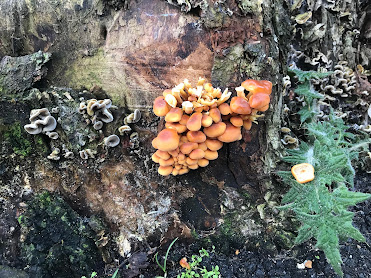friday fungi
I've been enthralled by Green Planet, David Attenborough's latest triumph, currently being screened by the BBC. The production values are just gorgeous, as we've come to expect from these films, but the stories behind the plants that we get up-close and personal with are just extraordinary.
I've been watching it on my own but, at least twice in every program, I've asked the TV (and any other piece of furniture that might be listening) 'How the actual Dickens does the plant know to do that?' If it wouldn't alarm my elderly neighbours, I'd be shouting the question.
What has been prompting this? Well, here's an example, we've seen a type of grass in Africa that needs its seed to be buried in the soil swiftly, in order to avoid it lying on the ground for any length of time in the extreme heat. So, it disguises its seeds as antelope dung in the hopes that the local dung beetles will roll the seeds away and bury them...at the perfect depth needed for the seed to germinate. This grass can shoot its seeds some distance from the parent plant (good for diversity), and those seeds are the same size, colour and shape as antelope dung, and what's more, they smell like antelope dung so the beetle has no idea it is being duped. How the Dickens does the plant know how to do this? How?
Another plant, an orchid from memory, needs to attract an insect to pollinate it. It has chosen the male from a particular species of wasp, and it produces flowers that are the same size, shape (in silhouette), and colourings as the female of the species. It even blooms at the same distance from the ground as the female wasp tends to rest in nearby shrubs, whilst awaiting a mate. Naturally sometimes the male will alight on a female wasp but sometimes he'll alight on an orchid and pick up pollen, which he'll then transfer to another flower when he gets duped again. How the Dickens does the plant know how to do this? How?
There are endless stories like these - trees communicating with each other down threads of fungi mycelium, like making a call down a telephone line. Carnivorous plants counting twenty seconds after an insect first trips its trap door response, awaiting the second signal that its actually an insect and not a raindrop that is triggering them. Plants 'talking', plants 'counting', plants assuming a disguise. How the Dickens?
These are just a few amazing examples from dozens in the show. I heartily recommend a watch, if your life is lacking a little sense of awe, wonder, and appreciation for Mother Nature. I came away with a new admiration for plant life, and determined to pay more attention to the greenery in the local streets, parks, and gardens. I stumbled upon this micro world of fungi and weeds at the base of a tree stump and had to take this photo. Take a look. Look at all the variety in just that one small space. It's a world in miniature. It's a blooming miracle.
Watching Green Planet also made me realise that fantasy writers, science fiction writers, horror writers are all being beaten at their own game, and have an awful lot of catching up to do. There is nothing you can imagine in your wildest dreams that nature didn't think of first.



Comments
Post a Comment